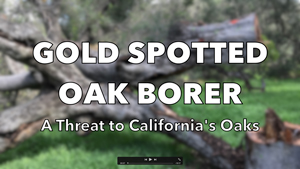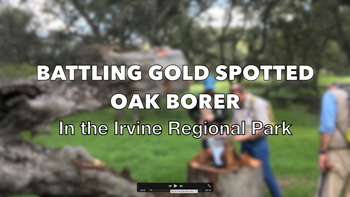Gold Spotted Oak Borer Threatens Oak Woodlands and Ecosystems across Southern California

The words used to describe oak trees are as strong as the hardwood species itself: majestic, stately, towering, ancient, regal.
But in Southern California, there’s another adjective increasingly used to describe oaks.
Dying.
From San Diego County to Los Angeles County, oak trees are dying rapidly, killed by a tiny beetle called the gold spotted oak borer. In areas where the invasive pest has become established, it’s killing 80 to 90 percent of the mature oaks – a dieback that’s fundamentally changing the landscape and the ecosystem the oaks support.
“If we lose these oak woodlands, we imagine it’ll be a conversion from a forest environment to a more open area, scrub and grasslands,” explained Dr. Tom Scott, a natural resource specialist with the University of California. “That’s a big loss in wildlife habitat. Oak woodlands provide the greatest number of resources of any habitat we have in Southern California and to lose them is to lose a lynchpin of the whole landscape.”
A Desert Southwest Invader
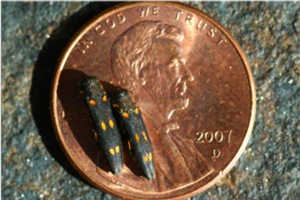 The gold spotted oak borer is native to Southern Arizona and Northern Mexico. In its natural habitat, where the native oaks are thin-barked and seasonal rains come in a late-summer monsoonal pattern, the beetle isn’t terribly destructive.
The gold spotted oak borer is native to Southern Arizona and Northern Mexico. In its natural habitat, where the native oaks are thin-barked and seasonal rains come in a late-summer monsoonal pattern, the beetle isn’t terribly destructive.
But things are different in Southern California and gold spotted oak borer is running amok.
First, the dominate oak species in the region are thick-barked varieties like coast live oak and canyon live oak, and the beetle seems to love them. Second, in California the rains come in the winter, not the summer. Researchers don’t yet know if or how that difference in rainfall seasonality affects oaks’ ability to fend off beetle attacks.
There may also be other factors that keep gold spotted oak borer in check in its native range, including insect predators or diseases. Right now, researchers don’t really know that either.
What they do know is that, unlike some insect pests that attack weakened hosts first, these beetles attack large healthy trees. The females lay their eggs in the protected cracks and crevices in the bark of an oak, and when the larvae emerge they bore through the bark into the cambium layer between the tree’s hardwood interior and bark.
The beetle larvae bore tunnels as they feed and develop in that protected cambium area where the tree is moving nutrients and water from its roots to its leaves. Eventually – and it doesn’t take long in a heavily infested tree – the larvae tunnels completely encircle or “girdle” the trunk and disrupt the tree’s circulatory system and the tree begins to die.
As they near adulthood, they bore their way back out toward the outer layer of bark and emerge in the spring as adults. They make a small D-shaped exit hole leaving the tree, which is how infested trees can be identified.
The problem is no one typically looks for those holes until their oaks start looking sickly.
“Wherever it pops up, we already know that tree is already infested and dying,” said Vilius Zukaskas, the U.S. Forest Service forester for the Angeles National Forest. “That’s one of the things that makes it hard to control.”
A San Diego Epicenter
Another vexing issue with the beetle is that they are adapt hitchhikers.
“The larvae can survive in firewood for up to two years before they emerge,” Scott said. “We believe that’s how they arrived in Southern California, in a load of firewood someone brought from Arizona.”
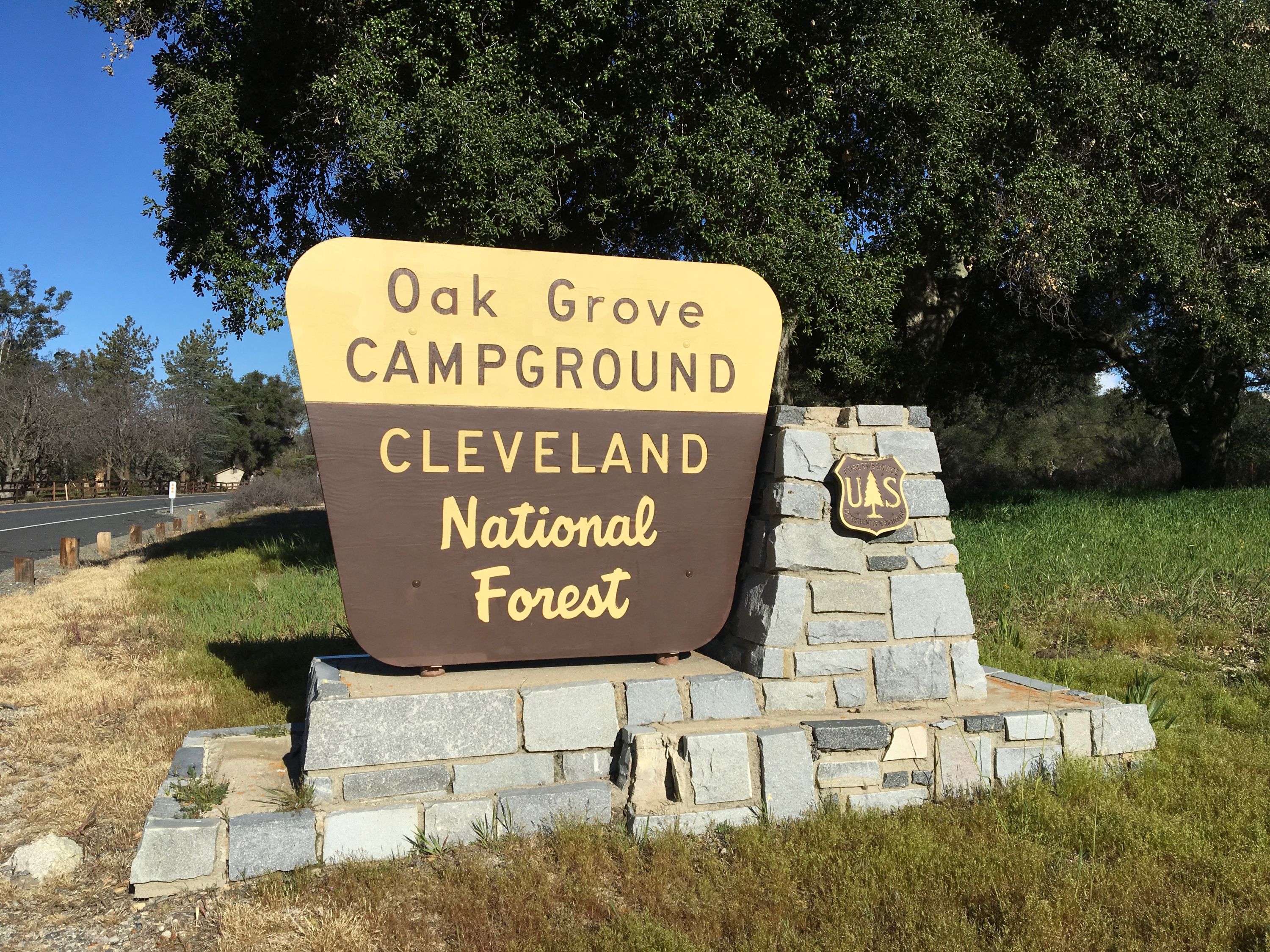 The beetle was first detected in San Diego County, and has caused significant dieback in the Cleveland National Forest, as well as on private land and county and state parks and recreation areas in San Diego County. The beetle isn’t a strong natural flier, but infestations are popping up miles away in new communities as far away as Orange and Los Angeles counties.
The beetle was first detected in San Diego County, and has caused significant dieback in the Cleveland National Forest, as well as on private land and county and state parks and recreation areas in San Diego County. The beetle isn’t a strong natural flier, but infestations are popping up miles away in new communities as far away as Orange and Los Angeles counties.
“Those long-distance jumps are through the movement of infested wood,” said Andrea Hefty, an entomologist with the U.S. Forest Service. “Then once gold spotted oak borer is found in a new community, it has the ability to naturally spread because the adults can fly.”
To contain the infestation to its current areas – and at the very least keep it from spreading beyond Southern California – agencies are cooperating to spread “Don’t move firewood” and “Buy it where you burn it” messages throughout the region.
“The last thing you want is to bring it up to Yosemite or anything like that,” Zukaskas said. “I always have that in the back of my mind whenever I see a truck going down the road, oh my gosh, where is it going?”
There’s no quarantine to prevent the movement of infested wood like there often is with invasive agricultural pests.
“We do need to look at that, the movement of wood, especially from known infested areas,” said Jeff McCracken, a director at the Green Valley Water District, whose town is fighting an infestation. “I think if they were to put a quarantine in now in the areas that are infected it would certainly save a lot of time, trouble and trees down the road.”
However, even proponents admit enforcing such a quarantine would be difficult.
A Few Bright Spots
So far, there hasn’t been a lot of good news surrounding the gold spotted oak borer, but a few positives have emerged.
One of those is a high level of inter-agency cooperation and coordination among the dozens of government agencies, private landowners and other entities with a stake in the outcome.
“In each county affected by gold spotted oak borer, we’ve tried to form a coalition of interest groups and agencies,” explained Kevin Turner, a forester with the California Department of Forestry and Fire Protection. “Typically that would include the forest service, the county ag commissioner, the University of California, and very often state parks, county parks and even city parks that are being impacted.”
Other partners include county fire departments, water districts, tribal governments and other federal agencies, like the Bureau of Indian Affairs, which helps tribes prepare for the appearance of the beetle on their lands.
An unlikely partner and ally in the battle has been the 11,000 sixth graders who attend Cuyamaca Outdoor School – better known as sixth grade camp – every year in San Diego County. Located in the Cuyamaca Rancho State Park, the school is near the hardest-hit area of the outbreak.
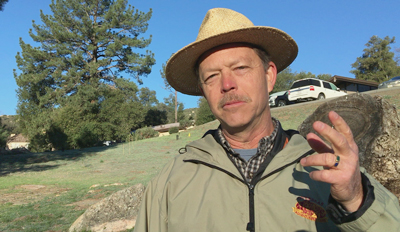 “I met a grad student at a workshop who said they didn’t have any data about the beetle in the park,” remembered Greg Schuette, the school’s principal. “I told her, ‘I have 11,000 scientists that can hep you out. They’re not very tall, but they can collect data, too.’”
“I met a grad student at a workshop who said they didn’t have any data about the beetle in the park,” remembered Greg Schuette, the school’s principal. “I told her, ‘I have 11,000 scientists that can hep you out. They’re not very tall, but they can collect data, too.’”
So after some planning and training, those sixth graders, who come to the camp for a week with their schools, began documenting the spread of the infestation in the park. They survey trees, find exit holes, document canopy dieback and see their observations incorporated into updated maps and material.
“The kids became very excited about that, being a part of a real science project,” Schuette said. “And we realized we were onto something and made our whole curriculum about citizen science projects. And it’s just exploded with enthusiasm and excitement – kids get excited about science.”
A Play for Time
Having 11,000 extra sets of eyes is a benefit, because managing the beetle is time consuming and resource intensive.
In infested areas, like Green Valley in the mountains above Los Angeles, a combination of volunteers and Los Angeles County Fire Department personnel survey trees. Heavily infested trees – also called amplifying trees or host trees because they can have upward of 3,000 beetles in them when nearby trees have just a few dozen – are removed or sprayed with a contact pesticide like carbaryl.
“Spraying amplifying trees is to encapsulate the beetles and keep them from emerging as adults,” Scott explained. “It can also prevent nearby healthy trees from being infested.”
However, for that barrier pesticide to be effective, it has to last. And to last, it has to be mixed at concentrations that only licensed pesticide applicators can legally apply. Unfortunately, in several infested areas, homeowners and others have tried to spray weaker garden-center varieties of the pesticide, or create their own concentrated version.>
Eventually, dying and dead trees have to be removed, and that’s where the real work begins. Because the beetles can survive under the bark even after the tree is cut down and sectioned, to truly stop them you have to strip the bark off the tree and burn it, bury it or chip it.
The Green Valley residents came up with the best way to do that so far, using log splitters to split off the outer bark. County fire and forestry crews were using chainsaws and axes to try to accomplish the same task, but bought their own log splitters when they saw how much faster the Green valley method was. Faster is a relative term, however.
“We can process a normal-sized tree in a day from felling it to chipping the bark,” said Kathleen Delos Reyes, a forestry technician with the Los Angeles County Fire Department. “That’s with a good-sized crew, say 12 or more. And then you have to make sure you haven’t left any bark that hasn’t been processed, so we have to clean up the whole site. And that takes the most work.”
The forest service recently began using air curtain burners to burn infested wood in Green Valley to speed up the process, as just in Green Valley hundreds of trees have come down. In Southern California, gold spotted oak borer has killed more than 80,000 trees.
Researchers and land managers are playing for time – hoping to slow to march of the beetles and the amount of destruction they do until more effective management strategies can be developed. Getting rid of the beetle probably won’t be possible. But scientists hope to come up with a way the region’s oaks can live with it.
“We’d love to have eradication, but it’s not likely,” Zukaskas said. “We’re here for the duration.”
